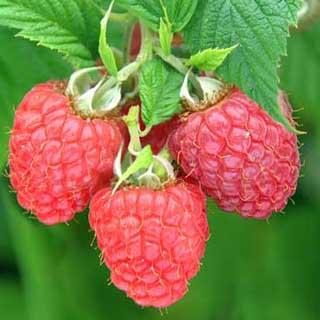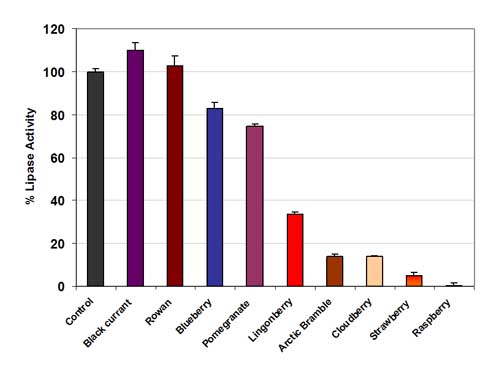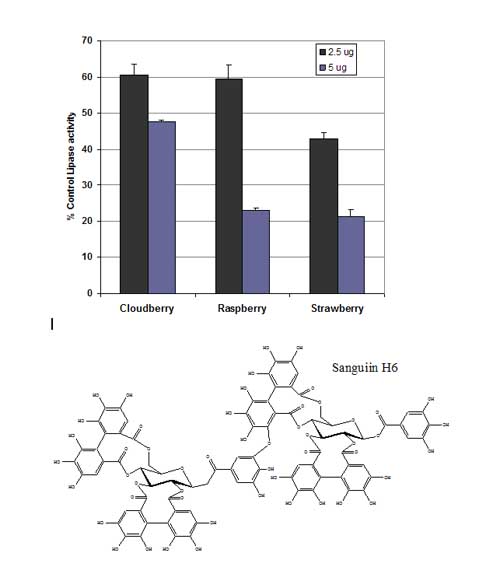Berry components may influence fat digestion and obesity
Published on 6 December 2010 in Food, health and wellbeing

Introduction
In Scotland, 1 in 4 adults can be categorised as obese1 with all projections suggesting an increasing trend over the next decades. As well as being a debilitating condition in its own right, obesity is a key contributing risk factor for cardiovascular disease, certain cancers, diabetes and the combination of risk factors known as Metabolic Syndrome. Obesity is a major drain on health-related spending. An unbalance between calorie intake and energy expenditure is the key factor in many cases of obesity and reductions in intake of energy dense fats may be useful to reduce weight. The suppression of fat digestion and subsequent intake by inhibiting the action of pancreatic lipase, which splits triglyceride fats into their absorbable glycerol and fatty acid constituents, is well accepted therapeutic means of treating obesity using drugs such as Orlistat (e.g. trade name Alli).
Key Points
Berries are rich in polyphenols and different species provide different combinations of components. There is mounting evidence that polyphenol components can have bioactivities relevant to diabetes, cardiovascular disease and cancer. There have also been reports that naturally occurring polyphenols can inhibit pancreatic lipase and influence fat digestion and energy intake2. Previous studies focused on polyphenols from teas and herbal sources but fruit polyphenols can also inhibit this enzyme.
Research Undertaken
A range of polyphenol-rich berry extracts and their sub-fractions were tested for effects on pancreatic lipase that could be relevant to fat digestion, energy intake and obesity3. By comparing the phytochemical diversity of the berry extracts with their anti-lipase effectiveness, key structural components were identified. Polyphenols from berries were effective inhibitors of pancreatic lipase in vitro.

Figure 1: Berry polyphenols inhibit pancreatic lipase. Each extract added at 50 µg/assay.
The most effective berry types were members of the Rubus family (raspberry, arctic bramble and cloudberry) and also strawberry. Known polyphenol composition of these berry types suggested that ellagitannins could be important. Purified ellagitannins from cloudberry and raspberry were also effective and structural differences between raspberry and cloudberry ellagitannins seemed important.

Figure 2: Lipase inhibition by purified berry tannins.
These components are effective at concentrations that would be readily achieved in the small intestine after eating berries and animal studies have shown that tannin-rich fruit extracts can decrease obesity, presumably through the mechanism of inhibition of pancreatic lipase and reduction in fat digestion and uptake. Future work to extend these studies to human trials is planned.
Policy Implications
Confirmation that these berry components influence fat digestion in humans could have implications for the treatment of obesity-related health problems. Berry-rich diets could be used in tandem with current anti-obesity drugs or polyphenol-rich supplements could be developed. Awareness of these health benefits could benefit the health of the general population, increase berry intake with possible associated benefits for farmers, crop breeders and food-based bio-industries.
References
1. Obesity in Scotland: an epidemiology briefing (ScotPHO, 2007)
2. McDougall, G.J. and Stewart, D. 2005. The inhibitory effects of polyphenols on digestive enzymes. Biofactors 23, 1-7.
3. McDougall, G.J., Kulkarni, N. and Stewart, D. 2009. Berry polyphenols inhibit pancreatic lipase activity in vitro. Food Chemistry 115, 193–199.
Author
Gordon McDougall Gordon.McDougall@scri.ac.uk







